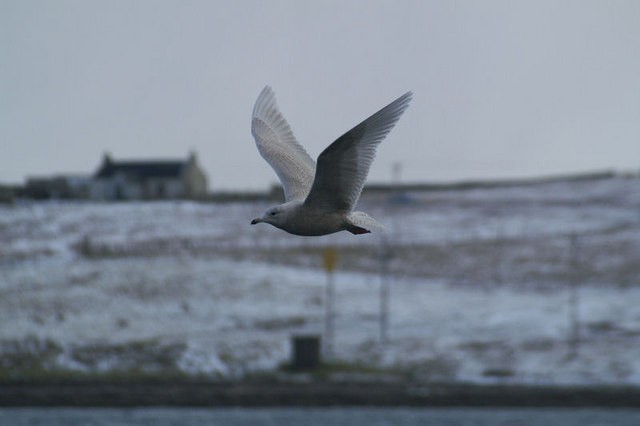Iceland Gull
A species of Gulls Scientific name : Larus glaucoides Genus : Gulls
Iceland Gull, A species of Gulls
Botanical name: Larus glaucoides
Genus: Gulls
Content
Description People often ask General Info
 Photo By Mike Pennington , used under CC-BY-SA-2.0 /Cropped and compressed from original
Photo By Mike Pennington , used under CC-BY-SA-2.0 /Cropped and compressed from original Description
The Iceland gull (Larus glaucoides) is a medium-sized gull that breeds in the Arctic regions of Canada and Greenland, but not in Iceland (as its name suggests), where it is only seen during winter. The genus name is from Latin larus, which appears to have referred to a gull or other large seabird. The specific name glaucoides denotes its resemblance to Larus glaucus, a synonym of Larus hyperboreus, the glaucous gull; -oides is Ancient Greek and means "resembling". It is migratory, wintering from in the North Atlantic as far south as the British Isles and northernmost states of the eastern United States, as well as in the interior of North America as far west as the western Great Lakes. It is much scarcer in Europe than the similar glaucous gull. The American taxon Kumlien's gull is often considered a subspecies, L. g. kumlieni, of Iceland gull. The taxon Thayer's gull is considered a subspecies, L. g. thayeri, of Iceland gull by the American Ornithological Society as of 2017. This species breeds colonially or singly on coasts and cliffs, making a nest lined with grass, moss, or seaweed on the ground or cliff. Normally, two or three light brown eggs are laid. They breed in Canada and Greenland, but not in Iceland. The nominate subspecies, L. g. glaucoides, is very pale in all plumage, with absolutely no melanin in the tips of the primaries in adult plumage. Adults are pale grey above, with a yellowish-green bill. Immatures are very pale grey; the bill is more extensively dark than with glaucous gull, and lacks pink. The Iceland gull is a medium-sized gull, although relatively slender and light in weight. In length, it can measure from 50 to 64 cm (20 to 25 in), wingspan is from 115 to 150 cm (45 to 59 in), and weight is from 480 to 1,100 g (1.06 to 2.43 lb). Among standard measurements, the wing chord is 37.9 to 44.3 cm (14.9 to 17.4 in), the bill is 3.6 to 5.4 cm (1.4 to 2.1 in), and the tarsus is 4.9 to 6.7 cm (1.9 to 2.6 in). It is smaller and thinner-billed than the very large glaucous gull, and is usually smaller than the herring gull. It takes four years to reach maturity. The call is a "laughing" cry like herring gull, but higher pitched. Like most Larus gulls, these are omnivores, eating fish, molluscs, offal, scraps, and eggs. They forage while flying, picking up food at or just below the water's surface, and they also feed while walking or swimming. Their scavenging habits lead them to frequent garbage dumps, sewage outlets, and places where fish are cleaned. 
Size
58-64 cm (23-25 in)
Life Expectancy
33 years
Nest Placement
Cliff
Clutch Size
1 - 4 eggs
Incubation Period
1 brood
Number of Broods
24 - 26 days
Nestling Period
42 - 52 days
Feeding Habits
Iceland Gull's diet primarily consists of fish taken from the sea surface, supplemented with mussels, snails, zooplankton, carrion, and fishing discards. Iceland Gull will also consume offal, garbage, eggs, and young from other birds' nests, and occasionally terrestrial plants, algae, and berries during late summer.
Habitat
Iceland Gull typically inhabits cold coastal regions, favoring rocky cliffs and fjords within the remote Arctic for breeding. These birds form large colonies, occasionally venturing a few miles inland. During the winter, they are mainly seen along seacoasts, frequenting beaches and intertidal zones. They adapt to a variety of foraging environments including shorelines, lawns, agricultural fields, and more rarely, garbage dumps. Iceland Gull prefers areas with minimal human disturbance but can occasionally be observed in urban settings.
Nest Behavior
Iceland Gull breeds in colonies and follows seasonal patterns for nest building and egg-laying. Both parents partake in incubating eggs and caring for the young.
Nest Characteristics
Iceland Gull nests are found on cliff ledges over 1,000 feet high or among rubble at cliff bases. They construct a shallow bowl with moss, grass, and feathers, sometimes reusing old nests.
Dite type
Omnivorous
People often ask
General Info
Feeding Habits
Bird food type
Behavior
Iceland Gull's typical behavior includes skimming the water's surface in elegant low flight to pick off food, often ingesting their catch mid-flight. Unlike the heavier flight patterns of their Glaucous and Herring Gull relatives, iceland Gull displays a more graceful flight as they forage. They interact closely with their habitat, taking advantage of the aquatic environment to feed and sustain their daily activities, which are characterized by their finesse both in air and while searching for nourishment.
Species Status
Not globally threatened.